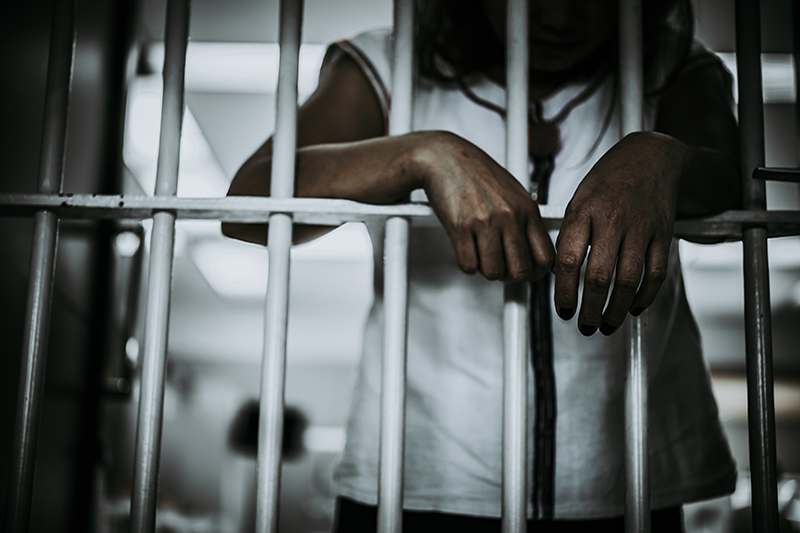Despite comprising just 8% of Australia’s prison population, female prisoners are the fastest-growing prison population in the country.
Between 2009 and 2019, Australia’s female prison population increased by 64% in Australia. And while the nation achieved a temporary decline in female prison rates in 2020 for the first time in years, rates increased again in 2021.
Who are they?
The increase in female incarceration disproportionately affects Australia’s most marginalised women. Incarcerated women in Australia are disproportionately represented in unemployment, mental health and homelessness statistics. And they’re disproportionately First Nations women.
While comprising 3% of the total female population, Aboriginal and Torres Strait Islander women make up one-third of Australia’s female prison population. This is unsurprising, given the criminalisation of women is primarily a criminalisation of the most marginalised.
While comprising 3% of the total female population, Aboriginal and Torres Strait Islander women make up one-third of Australia’s female prison population. This is unsurprising, given the criminalisation of women is primarily a criminalisation of the most marginalised.
First Nations women continue to suffer the persistent effects of colonisation and neo-colonial policies that drive ongoing marginalisation of First Nations women, families and communities, including poverty, underemployment, intergenerational trauma, violence against women, the removal of children, and poor mental health outcomes.
However, while the criminalisation of marginalisation disproportionately affects First Nations women, non-Indigenous women experiencing an accumulation of risk factors also increasingly face more punitive responses to their coping mechanisms and survival strategies.
Violence against women, surging prison population numbers
While all of Australia’s prison population is disproportionately affected by experiences of oppression and victimisation, these experiences are particularly high for women, with estimates that 85% have experienced violence at some point in their lives.
It’s been suggested that trauma and victimisation histories affect as many as 98% of the female prison population.
National and international research further suggests that between 40% and 73% of female prisoners have acquired brain injuries.
The bulk of this physical and emotional trauma is the result of male violence, including physical, sexual and/or emotional violence in childhood, adolescence and/or adulthood. For many incarcerated women, male violence is a persistent experience.
The short and long-term effects of male-perpetrated violence against women and girls are well-established, ranging from poor physical and mental health outcomes, self-medication and problematic substance use as a coping mechanism, disruption of educational opportunities, underemployment, homelessness, and increased risk of repeat victimisation over the life course.
Limited access to long-term recovery support more broadly, along with even fewer culturally safe and sensitive recovery interventions for First Nations women and girls, create an accumulation of risk factors associated with female offending behaviour, especially as it relates to drug-related offending, theft and property crimes.
Adverse effects of law reforms on marginalised women
Australia has in recent years seen a number of policy and law reforms to address the declared national emergency of domestic violence. As a result, policing practices have become more proactive.
While intended to protect women and children from male violence, female victim-survivors of family violence have increasingly found themselves misidentified by police as the alleged perpetrator of family violence.
Police-initiated protection orders now make up three-quarters of all applications, the number of breaches investigated by police has increased persistently in some jurisdictions, and an increasing number of breaches attract imprisonment.
In addition, bail laws have undergone substantial reforms in some states, including Victoria. While such policy and law reforms benefit a number of victim survivors, the adverse effects on marginalised populations are well-documented.
We must recognise that investing in primary prevention to end violence against women is an investment in crime prevention and reducing female incarceration rates.
The tightening of bail laws to ensure serious violent offenders remain in custody until sentenced, for example, has worked against the state’s First Nations women, who are disproportionately incarcerated under those law reforms.
While intended to protect women and children from male violence, female victim-survivors of family violence have increasingly found themselves misidentified by police as the alleged perpetrator of family violence, and have thus been subjected to tightened bail laws and tougher frontline police responses to family violence.
These recent policy and law reforms have adversely affected women who are not perceived to be an ideal victim, and women using force in the context of their victimisation experiences. This may be in the form of self-defence, retaliation, and/or to protect children who may otherwise become abuse targets.
And while misidentification affects a large number of female victim-survivors, especially where a skilled perpetrator manipulates the response system as part of his abusive tactics, the subsequent criminal justice responses disproportionately affect marginalised women who may present with an accumulation of risk factors, high levels of distress, and mistrust in law enforcement.
As a result, First Nations women, along with women presenting with mental health problems and/or problematic drug and/or alcohol use, are disproportionately affected by the adverse effects of policy and law reforms that were originally designed to protect them from male violence, and make up a substantial proportion of the female prison population, especially on remand while awaiting sentencing.
We must rethink the response to women’s offending behaviour
Incarceration has detrimental effects on women’s lives in general. And more than half of women entering prison in Australia report having dependent children. Even short-term incarceration can lead to the removal of children, barriers to reunification, job and housing loss.
More broadly, we must recognise that investing in primary prevention to end violence against women is an investment in crime prevention and reducing female incarceration rates.
The incarceration of mothers, therefore, has significant flow-on effects in the form of intergenerational trauma. Aside from the disruption to women’s lives caused by incarceration, it does little to address the underlying trauma associated with their (alleged) offending behaviour in the first place.
Most incarcerated women serve short prison terms, with much of it often spent unsentenced on remand, and with little if any access to recovery support and other person-centred interventions.
With an average cost of more than $300 per day to house a prisoner, the widely-recognised evidence that female offending differs from male offending in being less severe and less violent, and the growing evidence that the persistent increase in Australia’s female prison population is significantly driven by women’s victimisation histories associated with male violence, we should be investing in holistic and trauma-informed alternatives to incarceration, along with justice reinvestment programs that address the underlying risk factors and support needs of Australia’s most marginalised women.
In the context of First Nations women’s experiences, this must involve community-controlled and culturally-safe primary prevention, early intervention and healing programs to improve the lives of First Nations women, girls and their communities.
More broadly, we must recognise that investing in primary prevention to end violence against women is an investment in crime prevention and reducing female incarceration rates.
In the meantime, incarcerated women must have access to recovery and person-centred interventions that support successful transition from prison into education, employment, housing, and parenting responsibilities.
 Professor Silke Meyer is Deputy Director of the Gender and Family Violence Prevention Centre at Monash University. Silke is a criminologist and social worker, bringing practical and theoretical expertise to her research, teaching and writing. Her research centres on different aspects of domestic and family violence, including women and children’s safety and wellbeing, men’s accountability in their role as perpetrators and fathers, experiences specific to Aboriginal and Torres Strait Islander communities and the role of domestic and family violence-informed practice in child protection, policing and court proceedings.
Professor Silke Meyer is Deputy Director of the Gender and Family Violence Prevention Centre at Monash University. Silke is a criminologist and social worker, bringing practical and theoretical expertise to her research, teaching and writing. Her research centres on different aspects of domestic and family violence, including women and children’s safety and wellbeing, men’s accountability in their role as perpetrators and fathers, experiences specific to Aboriginal and Torres Strait Islander communities and the role of domestic and family violence-informed practice in child protection, policing and court proceedings.
This article is republished with permission from the Monash Lens, under a Creative Commons Licence; the original can be read here.
Picture © kittirat roekburi / Shutterstock


